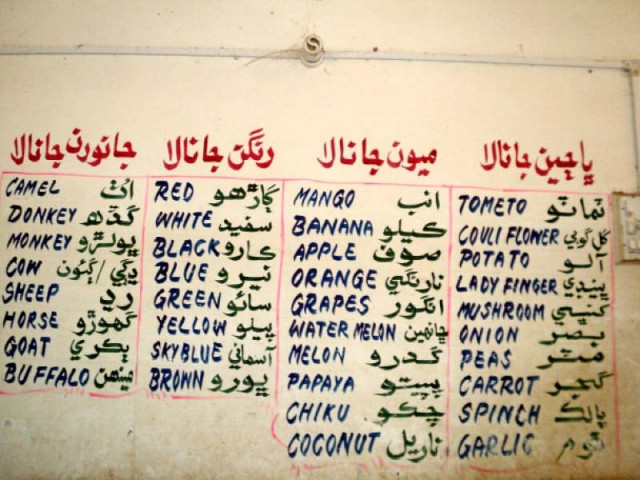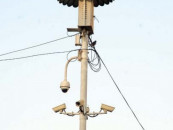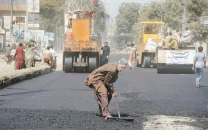Back to school: Green fields, white cotton. Unfit teachers, empty classes
Students of Khipro are more used to picking cotton than flipping pages

Many of the words in the ‘educational graffiti’ on the walls of the school are misspelt. However, Bharoo Mal, the teacher with 19 years of experience, insists that the spellings are correct. PHOTO: EXPRESS
In Government Primary School Muhammad Hayat Bozdar's small poorly-lit room, around 30 students sit on wooden benches — four on each one — as the teacher, Bharoo Mal, strolls lazily around the class in an unwashed kurta that was once brown in colour.
The walls of the room are covered with 'educational graffiti'; multiplication tables, alphabets, a list of fruits and vegetables, along with other things. Many of them are spelt incorrectly, with 'tometo' and 'alphabaetes' being the more unfortunate examples. However, Bharoo Mal, who has 19 years of teaching experience with a Primary Teaching Certificate (PTC), insists that the spellings are correct.
The students have the curriculum books on their laps — there are no desks — which are distributed free-of-charge by the provincial government. However, the books have a Rs35 price printed on the back. Poorly printed imitations of the free textbooks are being sold in the markets as the students are not being provided the originals. "I paid Rs40 for it," claimed grade-four student Qadir Bux.
The students are well-mannered, asking the teacher's permission before leaving and entering the classroom, and they stand up to greet anyone who comes into the room. However, that is where their education seemingly stops.
The students follow the information on the wall blindly. When given a simple division problem, grade-four student Tulsi looked to his right and promptly started copying the solution from the wall. However, changing the problem's values from 20/2 to 10/2 confused him; he did not recognise the '1' symbol, despite having written it down in the answer. To him, the numbers are just symbols, a confusing network of incomprehensible and meaningless lines, and while he can copy them down perfectly from the wall, he can do little else.
To avoid a crackdown over student absenteeism, Bharoo Mal marks all the students present. "I usually just mark the attendance at the end of the week or after 10-15 days," the teacher admits frankly. The attendance of the teachers is also questionable as Bharoo Mal, is the only one present, despite three teachers being employed at the school.
A mere half a kilometre away, a distance that encompasses three closed schools with 'pakka' buildings, a man stands in front of eight students. This blink-and-miss-it 'school', where the moustached Ismail Shah teaches this small group of students, is a branch of the Haji Jan Muhammad Hingorjo School. "I have done my Intermediate," claimed Shah, who has 28 years of experience in the field. However, Shah was not able to even spell 'inter', nor does he know the English alphabets.
Despite his shortcomings, the PTC-certified teacher takes home Rs32,000 to teach these eight kids, who often had to stop reading in order to shoo away a goat that kept coming inside to enjoy the cool shade of the thatched straw roof. Buffaloes stand in the building right next to this one, which is in much better condition than the school where the children sit.
Supervisor Nawab Ali Shah, in charge of monitoring the schools in the area, has written in his official notes that he is satisfied with the performance of the school and its teacher, and claims he found nothing wrong with the school during his visit.
A little further away, in the Muhammad Bachal Ranjar School, Nabi Bux and Muhammad Rahi try to calm down two classes full of unruly children. In Bux's class, only 20 have shown up out of a total of 56, but unlike Bharoo Mal's, the attendance register reflects it.
The boys in Bux's primary multi-grade class are all relatively better as they are able to solve basic addition problems and know how to spell common English words. However, this is not a co-ed school. "The girls' school is in the neighbouring building," said Bux. "But it is not functional, and is used to store cotton." The rooms of the locked red-bricked building are filled with white cotton, in stark contrast to the clean blackboard; the only evidence that the room is meant to be a classroom.
Education continues to suffer here in Khipro, as children spend more times in cotton fields than they do in classrooms, and till the trend does not change, the walls shall continue to say 'tometo'.
Published in The Express Tribune, March 17th, 2015.



















COMMENTS
Comments are moderated and generally will be posted if they are on-topic and not abusive.
For more information, please see our Comments FAQ